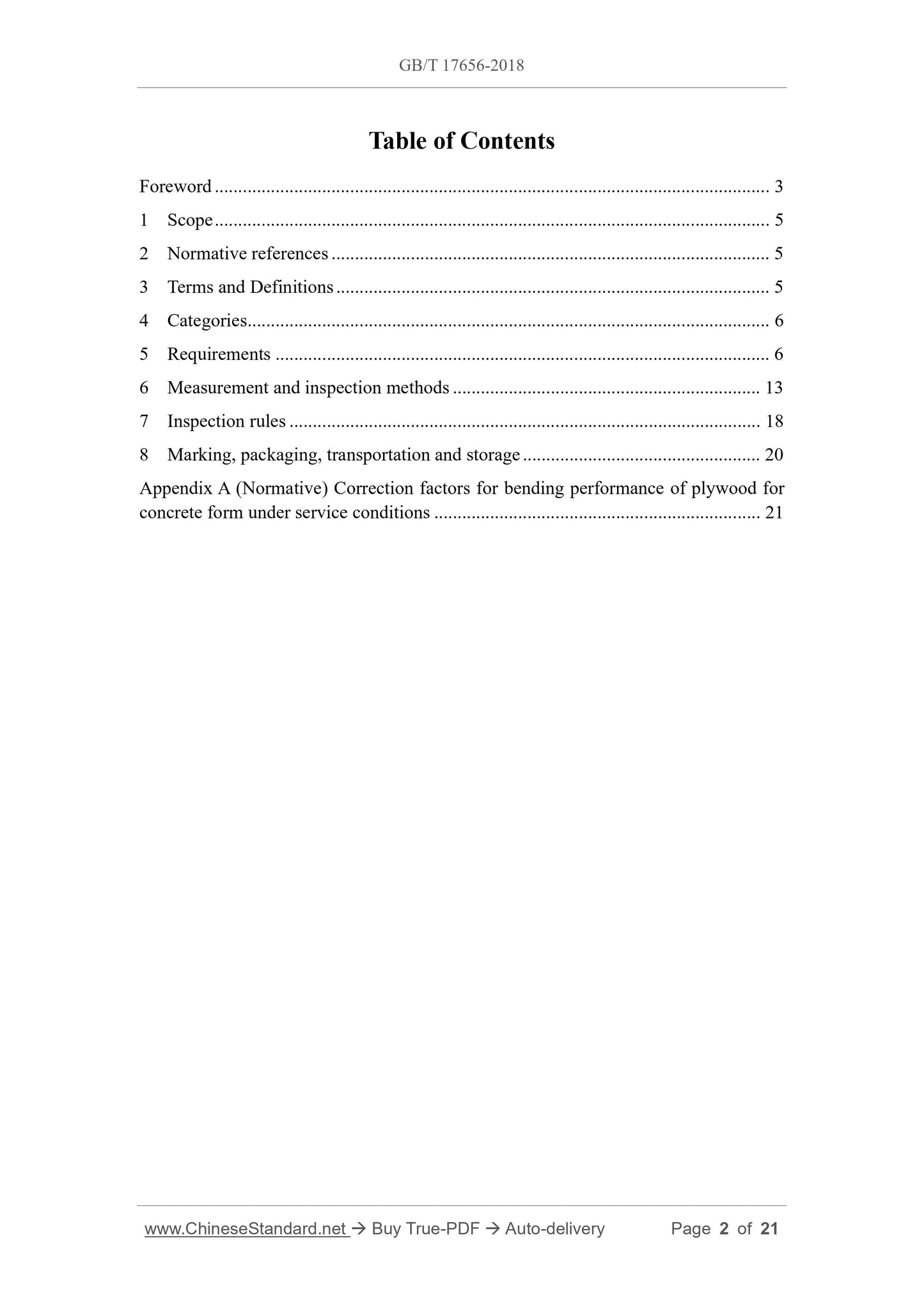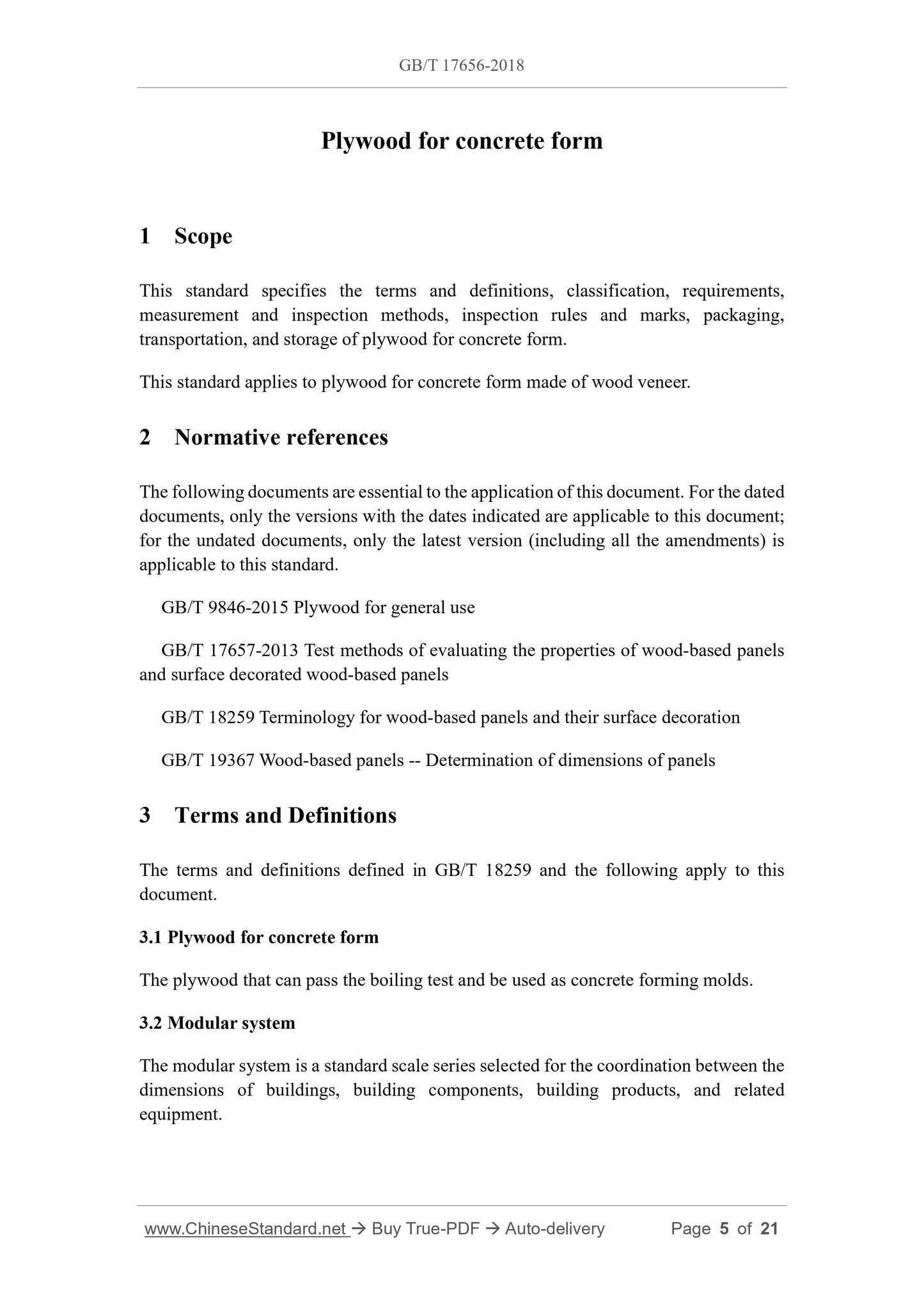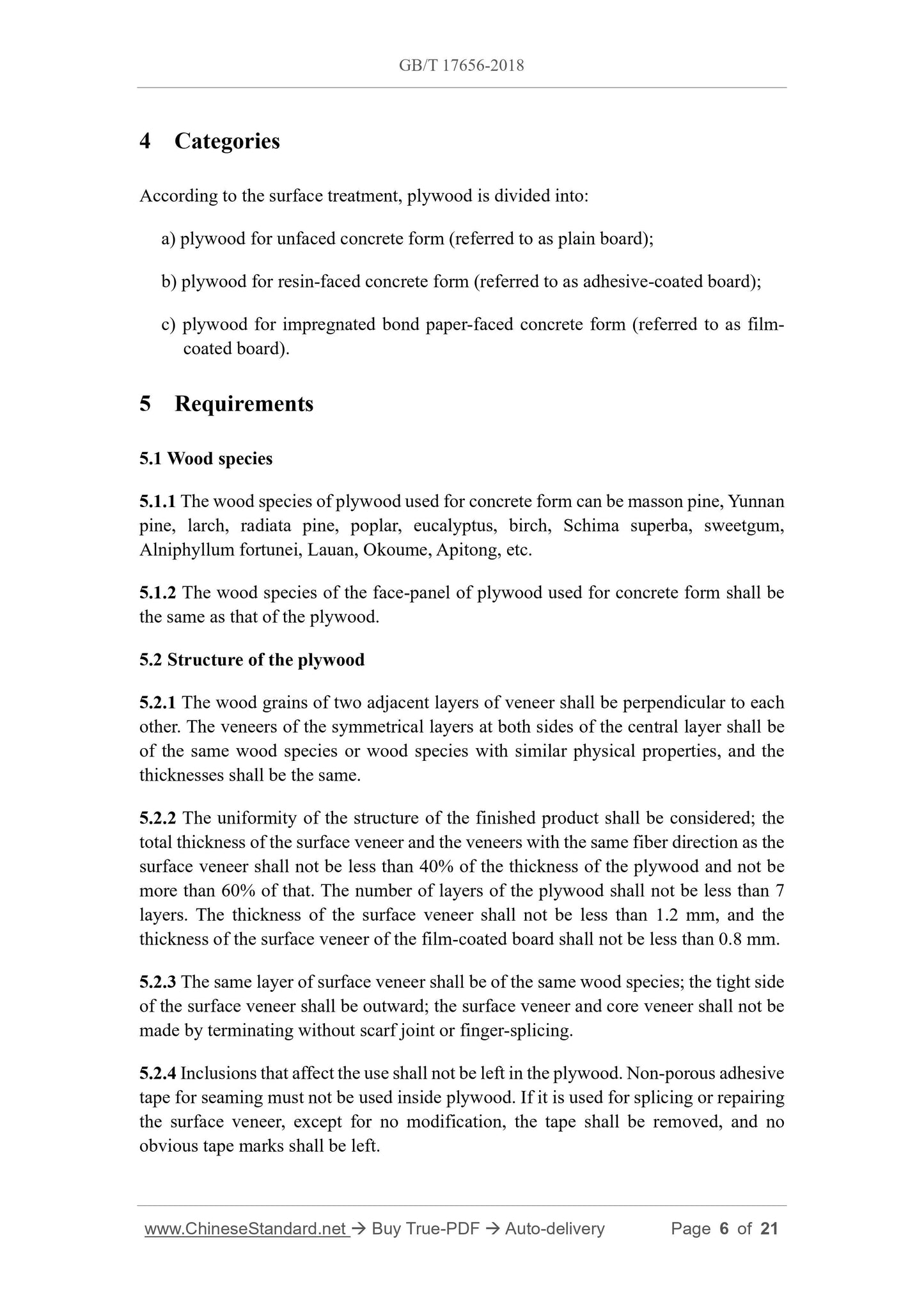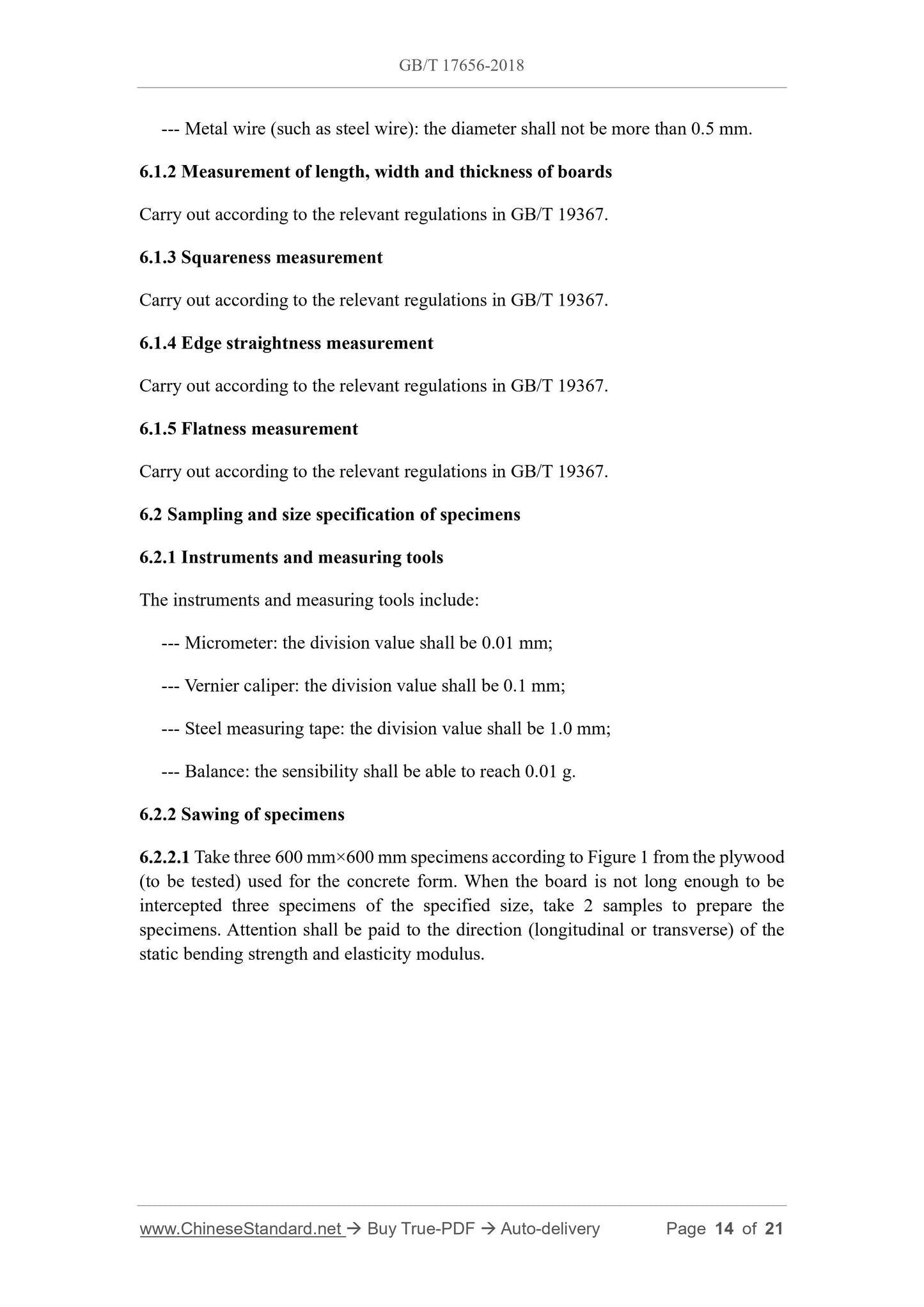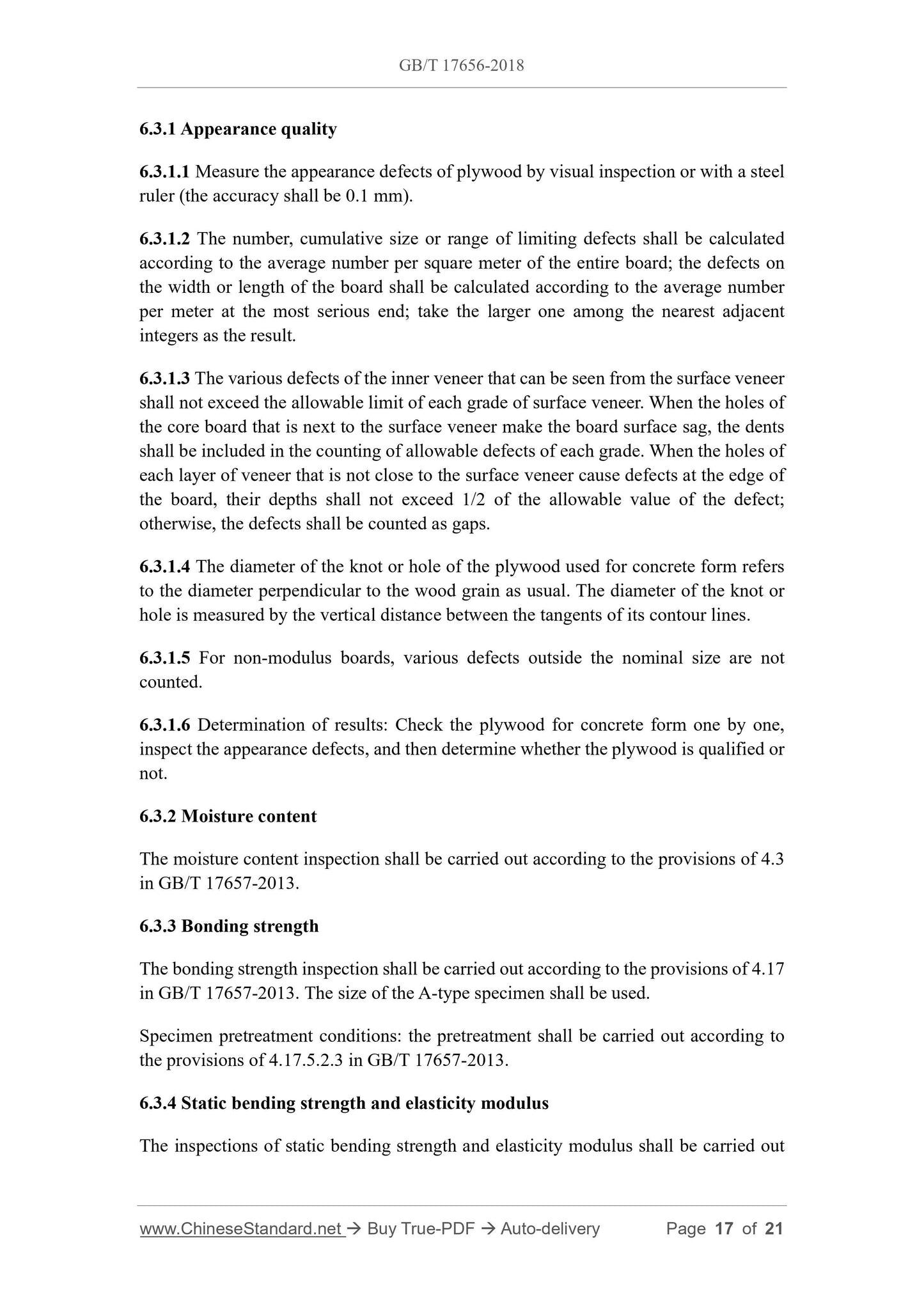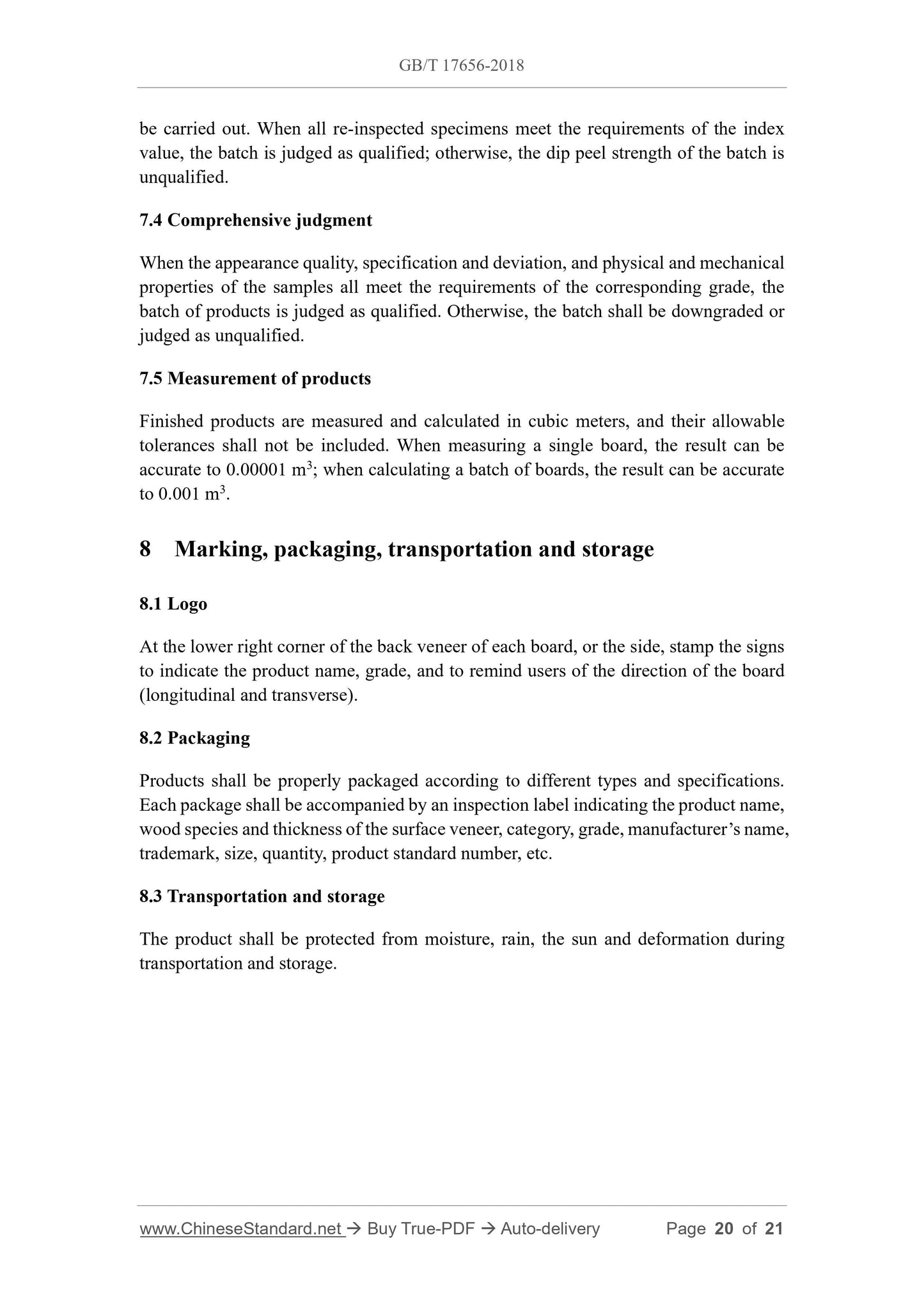1
/
su
9
PayPal, credit cards. Download editable-PDF and invoice in 1 second!
GB/T 17656-2018 English PDF (GBT17656-2018)
GB/T 17656-2018 English PDF (GBT17656-2018)
Prezzo di listino
$230.00 USD
Prezzo di listino
Prezzo scontato
$230.00 USD
Prezzo unitario
/
per
Spese di spedizione calcolate al check-out.
Impossibile caricare la disponibilità di ritiro
Delivery: 3 seconds. Download true-PDF + Invoice.
Get QUOTATION in 1-minute: Click GB/T 17656-2018
Historical versions: GB/T 17656-2018
Preview True-PDF (Reload/Scroll if blank)
GB/T 17656-2018: Plywood for concrete form
GB/T 17656-2018
NATIONAL STANDARD OF THE
PEOPLE’S REPUBLIC OF CHINA
ICS 79.060.10
B 70
Replace GB/T 17656-2008
Plywood for concrete form
ISSUED ON: MAY 14, 2018
IMPLEMENTED ON: DECEMBER 1, 2018
Issued by: State Administration for Market Regulation;
Standardization Administration of PRC.
Table of Contents
Foreword ... 3
1 Scope ... 5
2 Normative references ... 5
3 Terms and Definitions ... 5
4 Categories ... 6
5 Requirements ... 6
6 Measurement and inspection methods ... 13
7 Inspection rules ... 18
8 Marking, packaging, transportation and storage ... 20
Appendix A (Normative) Correction factors for bending performance of plywood for
concrete form under service conditions ... 21
Plywood for concrete form
1 Scope
This standard specifies the terms and definitions, classification, requirements,
measurement and inspection methods, inspection rules and marks, packaging,
transportation, and storage of plywood for concrete form.
This standard applies to plywood for concrete form made of wood veneer.
2 Normative references
The following documents are essential to the application of this document. For the dated
documents, only the versions with the dates indicated are applicable to this document;
for the undated documents, only the latest version (including all the amendments) is
applicable to this standard.
GB/T 9846-2015 Plywood for general use
GB/T 17657-2013 Test methods of evaluating the properties of wood-based panels
and surface decorated wood-based panels
GB/T 18259 Terminology for wood-based panels and their surface decoration
GB/T 19367 Wood-based panels -- Determination of dimensions of panels
3 Terms and Definitions
The terms and definitions defined in GB/T 18259 and the following apply to this
document.
3.1 Plywood for concrete form
The plywood that can pass the boiling test and be used as concrete forming molds.
3.2 Modular system
The modular system is a standard scale series selected for the coordination between the
dimensions of buildings, building components, building products, and related
equipment.
4 Categories
According to the surface treatment, plywood is divided into:
a) plywood for unfaced concrete form (referred to as plain board);
b) plywood for resin-faced concrete form (referred to as adhesive-coated board);
c) plywood for impregnated bond paper-faced concrete form (referred to as film-
coated board).
5 Requirements
5.1 Wood species
5.1.1 The wood species of plywood used for concrete form can be masson pine, Yunnan
pine, larch, radiata pine, poplar, eucalyptus, birch, Schima superba, sweetgum,
Alniphyllum fortunei, Lauan, Okoume, Apitong, etc.
5.1.2 The wood species of the face-panel of plywood used for concrete form shall be
the same as that of the plywood.
5.2 Structure of the plywood
5.2.1 The wood grains of two adjacent layers of veneer shall be perpendicular to each
other. The veneers of the symmetrical layers at both sides of the central layer shall be
of the same wood species or wood species with similar physical properties, and the
thicknesses shall be the same.
5.2.2 The uniformity of the structure of the finished product shall be considered; the
total thickness of the surface veneer and the veneers with the same fiber direction as the
surface veneer shall not be less than 40% of the thickness of the plywood and not be
more than 60% of that. The number of layers of the plywood shall not be less than 7
layers. The thickness of the surface veneer shall not be less than 1.2 mm, and the
thickness of the surface veneer of the film-coated board shall not be less than 0.8 mm.
5.2.3 The same layer of surface veneer shall be of the same wood species; the tight side
of the surface veneer shall be outward; the surface veneer and core veneer shall not be
made by terminating without scarf joint or finger-splicing.
5.2.4 Inclusions that affect the use shall not be left in the plywood. Non-porous adhesive
tape for seaming must not be used inside plywood. If it is used for splicing or repairing
the surface veneer, except for no modification, the tape shall be removed, and no
obvious tape marks shall be left.
--- Metal wire (such as steel wire): the diameter shall not be more than 0.5 mm.
6.1.2 Measurement of length, width and thickness of boards
Carry out according to the relevant regulations in GB/T 19367.
6.1.3 Squareness measurement
Carry out according to the relevant regulations in GB/T 19367.
6.1.4 Edge straightness measurement
Carry out according to the relevant regulations in GB/T 19367.
6.1.5 Flatness measurement
Carry out according to the relevant regulations in GB/T 19367.
6.2 Sampling and size specification of specimens
6.2.1 Instruments and measuring tools
The instruments and measuring tools include:
--- Micrometer: the division value shall be 0.01 mm;
--- Vernier caliper: the division value shall be 0.1 mm;
--- Steel measuring tape: the division value shall be 1.0 mm;
--- Balance: the sensibility shall be able to reach 0.01 g.
6.2.2 Sawing of specimens
6.2.2.1 Take three 600 mm×600 mm specimens according to Figure 1 from the plywood
(to be tested) used for the concrete form. When the board is not long enough to be
intercepted three specimens of the specified size, take 2 samples to prepare the
specimens. Attention shall be paid to the direction (longitudinal or transverse) of the
static bending strength and elasticity modulus.
6.3.1 Appearance quality
6.3.1.1 Measure the appearance defects of plywood by visual inspection or with a steel
ruler (the accuracy shall be 0.1 mm).
6.3.1.2 The number, cumulative size or range of limiting defects shall be calculated
according to the average number per square meter of the entire board; the defects on
the width or length of the board shall be calculated according to the average number
per meter at the most serious end; take the larger one among the nearest adjacent
integers as the result.
6.3.1.3 The various defects of the inner veneer that can be seen from the surface veneer
shall not exceed the allowable limit of each grade of surface veneer. When the holes of
the core board that is next to the surface veneer make the board surface sag, the dents
shall be included in the counting of allowable defects of each grade. When the holes of
each layer of veneer that is not close to the surface veneer cause defects at the edge of
the board, their depths shall not exceed 1/2 of the allowable value of the defect;
otherwise, the defects shall be counted as gaps.
6.3.1.4 The diameter of the knot or hole of the plywood used for concrete form refers
to the diameter perpendicular to the wood grain as usual. The diameter of the knot or
hole is measured by the vertical distance between the tangents of its contour lines.
6.3.1.5 For non-modulus boards, various defects outside the nominal size are not
counted.
6.3.1.6 Determination of results: Check the plywood for concrete form one by one,
inspect the appearance defects, and then determine whether the plywood is qualified or
not.
6.3.2 Moisture content
The moisture content inspection shall be carried out according to the provisions of 4.3
in GB/T 17657-2013.
6.3.3 Bonding strength
The bonding strength inspection shall be carried out according to the provisions of 4.17
in GB/T 17657-2013. The size of the A-type specimen shall be used.
Specimen pretreatment conditions: the pretreatment shall be carried out according t...
Get QUOTATION in 1-minute: Click GB/T 17656-2018
Historical versions: GB/T 17656-2018
Preview True-PDF (Reload/Scroll if blank)
GB/T 17656-2018: Plywood for concrete form
GB/T 17656-2018
NATIONAL STANDARD OF THE
PEOPLE’S REPUBLIC OF CHINA
ICS 79.060.10
B 70
Replace GB/T 17656-2008
Plywood for concrete form
ISSUED ON: MAY 14, 2018
IMPLEMENTED ON: DECEMBER 1, 2018
Issued by: State Administration for Market Regulation;
Standardization Administration of PRC.
Table of Contents
Foreword ... 3
1 Scope ... 5
2 Normative references ... 5
3 Terms and Definitions ... 5
4 Categories ... 6
5 Requirements ... 6
6 Measurement and inspection methods ... 13
7 Inspection rules ... 18
8 Marking, packaging, transportation and storage ... 20
Appendix A (Normative) Correction factors for bending performance of plywood for
concrete form under service conditions ... 21
Plywood for concrete form
1 Scope
This standard specifies the terms and definitions, classification, requirements,
measurement and inspection methods, inspection rules and marks, packaging,
transportation, and storage of plywood for concrete form.
This standard applies to plywood for concrete form made of wood veneer.
2 Normative references
The following documents are essential to the application of this document. For the dated
documents, only the versions with the dates indicated are applicable to this document;
for the undated documents, only the latest version (including all the amendments) is
applicable to this standard.
GB/T 9846-2015 Plywood for general use
GB/T 17657-2013 Test methods of evaluating the properties of wood-based panels
and surface decorated wood-based panels
GB/T 18259 Terminology for wood-based panels and their surface decoration
GB/T 19367 Wood-based panels -- Determination of dimensions of panels
3 Terms and Definitions
The terms and definitions defined in GB/T 18259 and the following apply to this
document.
3.1 Plywood for concrete form
The plywood that can pass the boiling test and be used as concrete forming molds.
3.2 Modular system
The modular system is a standard scale series selected for the coordination between the
dimensions of buildings, building components, building products, and related
equipment.
4 Categories
According to the surface treatment, plywood is divided into:
a) plywood for unfaced concrete form (referred to as plain board);
b) plywood for resin-faced concrete form (referred to as adhesive-coated board);
c) plywood for impregnated bond paper-faced concrete form (referred to as film-
coated board).
5 Requirements
5.1 Wood species
5.1.1 The wood species of plywood used for concrete form can be masson pine, Yunnan
pine, larch, radiata pine, poplar, eucalyptus, birch, Schima superba, sweetgum,
Alniphyllum fortunei, Lauan, Okoume, Apitong, etc.
5.1.2 The wood species of the face-panel of plywood used for concrete form shall be
the same as that of the plywood.
5.2 Structure of the plywood
5.2.1 The wood grains of two adjacent layers of veneer shall be perpendicular to each
other. The veneers of the symmetrical layers at both sides of the central layer shall be
of the same wood species or wood species with similar physical properties, and the
thicknesses shall be the same.
5.2.2 The uniformity of the structure of the finished product shall be considered; the
total thickness of the surface veneer and the veneers with the same fiber direction as the
surface veneer shall not be less than 40% of the thickness of the plywood and not be
more than 60% of that. The number of layers of the plywood shall not be less than 7
layers. The thickness of the surface veneer shall not be less than 1.2 mm, and the
thickness of the surface veneer of the film-coated board shall not be less than 0.8 mm.
5.2.3 The same layer of surface veneer shall be of the same wood species; the tight side
of the surface veneer shall be outward; the surface veneer and core veneer shall not be
made by terminating without scarf joint or finger-splicing.
5.2.4 Inclusions that affect the use shall not be left in the plywood. Non-porous adhesive
tape for seaming must not be used inside plywood. If it is used for splicing or repairing
the surface veneer, except for no modification, the tape shall be removed, and no
obvious tape marks shall be left.
--- Metal wire (such as steel wire): the diameter shall not be more than 0.5 mm.
6.1.2 Measurement of length, width and thickness of boards
Carry out according to the relevant regulations in GB/T 19367.
6.1.3 Squareness measurement
Carry out according to the relevant regulations in GB/T 19367.
6.1.4 Edge straightness measurement
Carry out according to the relevant regulations in GB/T 19367.
6.1.5 Flatness measurement
Carry out according to the relevant regulations in GB/T 19367.
6.2 Sampling and size specification of specimens
6.2.1 Instruments and measuring tools
The instruments and measuring tools include:
--- Micrometer: the division value shall be 0.01 mm;
--- Vernier caliper: the division value shall be 0.1 mm;
--- Steel measuring tape: the division value shall be 1.0 mm;
--- Balance: the sensibility shall be able to reach 0.01 g.
6.2.2 Sawing of specimens
6.2.2.1 Take three 600 mm×600 mm specimens according to Figure 1 from the plywood
(to be tested) used for the concrete form. When the board is not long enough to be
intercepted three specimens of the specified size, take 2 samples to prepare the
specimens. Attention shall be paid to the direction (longitudinal or transverse) of the
static bending strength and elasticity modulus.
6.3.1 Appearance quality
6.3.1.1 Measure the appearance defects of plywood by visual inspection or with a steel
ruler (the accuracy shall be 0.1 mm).
6.3.1.2 The number, cumulative size or range of limiting defects shall be calculated
according to the average number per square meter of the entire board; the defects on
the width or length of the board shall be calculated according to the average number
per meter at the most serious end; take the larger one among the nearest adjacent
integers as the result.
6.3.1.3 The various defects of the inner veneer that can be seen from the surface veneer
shall not exceed the allowable limit of each grade of surface veneer. When the holes of
the core board that is next to the surface veneer make the board surface sag, the dents
shall be included in the counting of allowable defects of each grade. When the holes of
each layer of veneer that is not close to the surface veneer cause defects at the edge of
the board, their depths shall not exceed 1/2 of the allowable value of the defect;
otherwise, the defects shall be counted as gaps.
6.3.1.4 The diameter of the knot or hole of the plywood used for concrete form refers
to the diameter perpendicular to the wood grain as usual. The diameter of the knot or
hole is measured by the vertical distance between the tangents of its contour lines.
6.3.1.5 For non-modulus boards, various defects outside the nominal size are not
counted.
6.3.1.6 Determination of results: Check the plywood for concrete form one by one,
inspect the appearance defects, and then determine whether the plywood is qualified or
not.
6.3.2 Moisture content
The moisture content inspection shall be carried out according to the provisions of 4.3
in GB/T 17657-2013.
6.3.3 Bonding strength
The bonding strength inspection shall be carried out according to the provisions of 4.17
in GB/T 17657-2013. The size of the A-type specimen shall be used.
Specimen pretreatment conditions: the pretreatment shall be carried out according t...
Share

